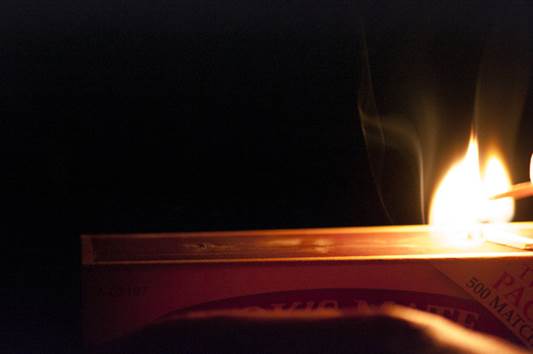Performance
There’s no storm at the time I performed
the test so I have to replace the lightning with a test that replaces that
feature. I chose a cigarette lighter. At first, I didn’t expect that I’d get
the sparks when it burned, but the delay of the camera shutter made me
disappointed. Though it’s about 100 mili seconds or longer, it’s too late to
capture the accurate time of ignition. Instead of that I saw the image of the
lighter in nearly full flame with just a remnant of a spark still hanging in
the air.

Light-activating
test
Then I tested with a match with the same
expectation and saw that the match also burned too fast for the initial spark
to be missed. The only control you can do was adjusting sensitivity, I
performed it on the top and it received the light from the room lights which
were dimmed and continued to activate the camera. So I had to turn them off. I
can also lower the sensitivity of the triggers, so the dimmed room lights had
gone beyond of their limit, but this could affect the performance.

Light-activating
test
Coming up next is sound mode. I tried both
flame and tests with the light from the above by using a sound sensor but the
result was unchanged. With a popping balloon where you can use the flash to
light up, that’s another problem, though it’s the same event with high speed.
The flash has no delay and provides a much higher period of time, so the
explosion of the airship can be taken on the camera. I put the camera on B in a
dark environment and attach the flash with a Nero trigger. The sound of the
popping balloon activates the flash and the exposure is performed instantly.

Testing
with funnel-type images
All of them are very easy to use. And if
you want to set a shot duration, there will be an option to do so in a
millisecond. I use this feature for the funnel-shaped shots and can be able to
control the length of the material ejecting from the funnel. Besides, there’s a
lock so that just 1 image can be captured when there’s lots of recorded noise.

Activating
with sound
I have some problems with the trigger when
using it on Pentax K20 – the unit recorded noise right from the 1st
explosion, but failed to activate the camera, the second time always ended up
in good results. It performed this every time the device was on. I don’t have
the same problem with Olympus OM-D and Nero can overcome the problem, so the
issue here is on the camera, one of the problems when using Pentax – it seems
that the company just test automatically on the market with a majority of the
Nikon and Canon products but doesn’t do any research on the less-reputation
brands.
Next is Timelapse. The long exposure mode
of Nero Multi-Trigger was integrated together with Timelapse, thus, you can set
up a frame and exposure mode in duration from 1 second to 59 minutes 59
seconds. The scene below is 81second exposure mode by using the Lee Big Stopper
filter to allow a cloud-shaped image moves its style.

Exposure
mode
One of the annoying things about long
exposure mode is when for some reasons, you decide to cancel this long exposure
process. If you’re trying to have another one, the timer will continue from the
time you cancel. Therefore, you have to wait until the counting-back process
ends. The only way around this problem is to turn the device off and turn it on
one more time, then navigate back to Timelapse mode. It’s not very ideal.
Timelapse feature is best-used when
recoding a series of shots from changing events, such as the start of the path,
opening flowers, burning candle, spoiled food…
Nero Trigger can be set to record some
images during exposure time and the time between the exposures. Unlike Hahnel
Giga-T Pro having no combined options for delay, so you can set it up to begin
with a specific delay time, for example, to begin recording at dawn when you’re
still in a sound sleep on your bed.